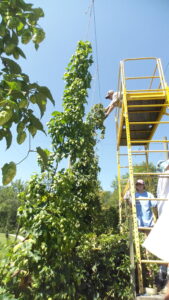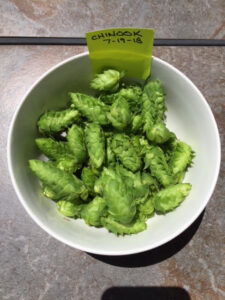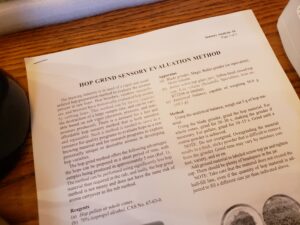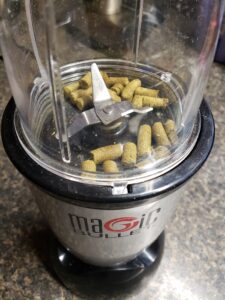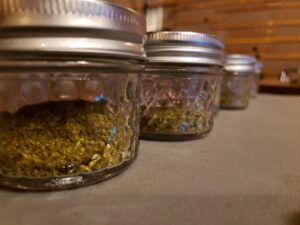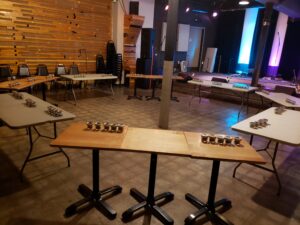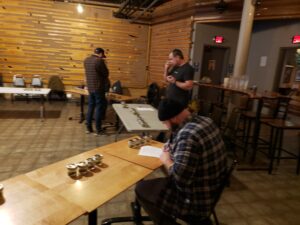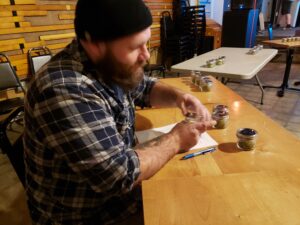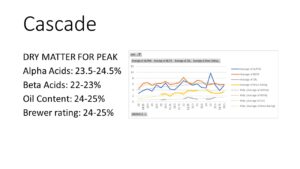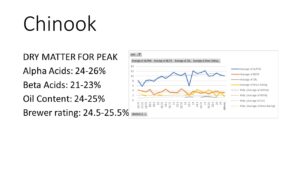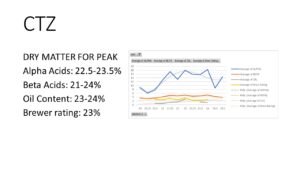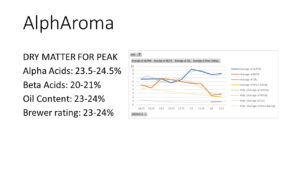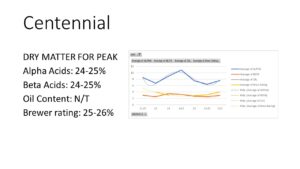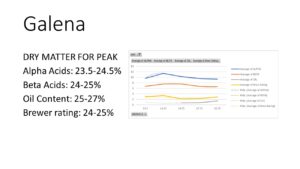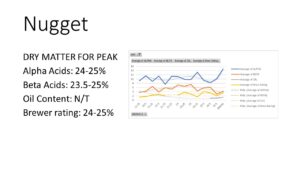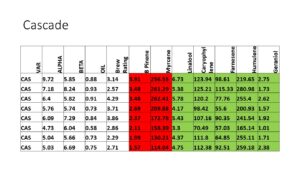Final report for FNC18-1148
Project Information
The group is composed of the following.
Project coordinator Dave Volkman, owner of Ohio Valley Hops, a 1 ½ acre hopyard he and his wife started in 2012. Dave is a founder of the Ohio Hop Growers Guild (OHGG) and is currently the chair of their Board of Directors. He has spoken about Ohio hops at the last two annual conventions of the Ohio Craft Brewers Association, and is scheduled again for 2018, and has been a featured speaker at the Ohio State University hops conference, at two county Farm Bureau annual meetings, and on several podcasts. He is also Ohio’s representative on the Hop Grower’s of America Small Grower Council. He is one of three Ohio growers with a mobile hop harvester and does custom work across the state.
Brady Kirwan and his wife Amanda own Old Dutch Hops, a 2 acre hopyard they started in 2013 and Ohio’s only OEFFA certified organic hop farm. Brady is past Secretary of the OHGG and an active member of the OHGG Standards and Member Services committees, and also owns a mobile harvester, doing custom work.
Jamie Arthur owns Little Miami Farms, a 1 acre hopyard he started in 2013, and is a past director of the OHGG and chair of our member services committee, assisting Ohio growers with bulk purchasing of hop growing supplies, and is also spearheading the advancement of Ohio malting barley.
Dan Hoy, owner of Hidden Lake Farm has grown 1 ½ acres of hops since 2015 and is chair of the OHGG Standards committee, and led the development of hop growing quality standards in coordination with the Ohio Craft Brewers Association to ensure Ohio hops meet the highest standards from planting through processing, the first of its kind in Midwestern states.
All have sold hops to Ohio craft brewers and developed a strong understanding of brewer requirements.
We will determine the optimal harvest time of ten popular hop varieties in Ohio.
Hop farming is growing in Midwestern agriculture, composed of many small farmers. As craft brewing has grown, so has demand for ingredients. Brewers express strong desire for local hops, but demand quality that meets industry standards for chemistry and excellent aroma and flavor. Much of this is determined by growing practices, particularly harvest timing. Hops have an optimal harvest time, and exhibit noticeable increase, peak and decrease of chemical components that affect crop quality. Large commercial growers in the Pacific Northwest (with decades of experience and scientific staffs) know these optimal harvest windows, but it’s proprietary information, unknown to Midwestern growers, and may vary by region, even if we had their data. Those growers acknowledge harvest ranges from 18% to 26% dry matter content, unique to each variety. Determining what those numbers are for leading varieties here will greatly improve the economic viability of this high value specialty crop by ensuring the highest quality and therefore most competitive hop. As growers gain required knowledge and experience, quality, demand and profit will increase.
- Determine the optimal harvest timing of ten of the most popular hop varieties grown in Ohio.
- Share findings widely with other growers across the Midwest and Northeast through website, social media and conference presentations.
- Share findings with the Ohio Craft Brewers Association to promote advances in quality, and encourage other state’s growers to do the same with their affiliated brewers associations.
Research
May-July 2018. Bought supplies, met with participants to confirm procedures and deliver supplies.
July-September 2018. Dry Matter Grower Instructions Growers picked a 60 gram sample of designated varieties weekly, commencing five weeks after variety bloom (the time needed to reach early maturity). Each vacuum sealed a 30 gram sample of each variety, and shipped to a testing lab for analysis. Sample Lab Report AAR Labs Growers also dried 30 grams to 8-10% moisture, vacuum sealed, labelled and froze for later use at a brewers’ sensory evaluation panel. In 2018, weather patterns were unusual, leading to several growers being unable to participate as harvest came weeks earlier than anticipated.
October-November 2018. Compiled the lab results of each variety in a data table, determining when each reached its peak values for five data points important to brewers, according to moisture content.
Summer 2019. Completed testing that was not completed in summer 2018.
December 2019. We assembled a panel of craft brewers from Cincinnati's Rhinegeist Brewing, Madtree Brewing, Taft's Brewing, Brink Brewing, Urban Artifact Brewing and Fibonacci Brewing, who collectively have won numerous major national awards for their beers. We conducted blind evaluations of each variety using the American Society of Brewing Chemists Method 16 Hop Grind for hop aroma evaluation. sensoryanalysis-16 Brewers evaluated and ranked the samples for best aromatic properties within a variety, taking notes on their characteristics. I compiled their scores and added to my lab analysis on a pivot chart to determine optimal hop harvest timing.
January 2020. We will compile data to identify the window of optimal harvest timing for chemistry and aroma based on lab tests and brewer evaluations and publish this for use by brewers and growers.
Weather conditions were unusual the two summers of this grant, leading to us not being able to conduct thorough testing on ten varieties. We have what we believe are valid and useful results on four varieties, preliminary but helpful on three varieties, and incomplete on the other three due to not having enough samples to consider the results meaningful.
We sent all of our hop samples to Advanced Analytical Research labs in Madison Wisconsin, which conducted several tests on the hops. In 2019, AAR upgraded some equipment and began offering an even more useful test which gave us more detailed information on the oil content of our hops, which we consider to be an unexpected bonus for growers and brewers. AAR included American Society of Brewing Chemist methods Hops-12, Hops-13, Hops-14, Hops-17, Hops-4C, which provided us with % alpha Acids, cohumulone, % beta Acids, colupulone, beta-pinene, myrcene, linalool, caryophyllene, farnesene, humulene, and geraniol levels, moisture dry matter, Hop Storage Index, and total oil content (mL/100g).
We determined what we consider to be useful information for our growers and brewers. Pivot charts are attached showing these results.
For our brewers sensory panel, we prepared our hop samples in accordance with the American Society of Brewing Chemist Method 16- Hop Grind. We divided varieties into flights of 5-6 samples. Brewers were not given any in formation about the variety or harvest stage when it was picked, to avoid any bias towards or against certain hops. Brewers were provided with evaluation sheets to numerically rate and provide comments. These results were compiled and included in the pivot charts (attached).
Upon compilation, we were able to see, as expected, that key chemical components of the hops (alpha and beta acids, and oils) had definite patterns according to hop dry matter, and that brewers preferences definitely peaked at a particular dry matter.
Educational & Outreach Activities
Participation Summary:
Prior to beginning, we made our study goals and expected outcomes widely known in the Ohio hop growing and craft brewing communities, where there is much interest for its usefulness. Hop growing is still fairly new to the Midwest, and best practices are still being established.
We developed a flyer and presentation with all lab data and brewer sensory evaluations, clearly identifying the window of optimal harvest timing for each variety by chemistry and aroma based on lab tests and brewer evaluations and publish this for use by brewers and growers.
We shared all this information through the Ohio Hop Growers Guild’s website and Facebook pages, and also on a Facebook national hop growers’ forum that has over 1800 members. As partners of the Hops Research program at the Ohio State University, we shared with them and through Ohio State’s email listserve. We will share with the Hop Growers of America Small Grower Council, which will make it available to statewide associations in Indiana, Kentucky, Michigan, Nebraska, New York, Virginia and Wisconsin. We will make results and videos of the lab and sensory evaluation available on request. Optimal Harvest Timing flyer We presented our findings at the 7th annual Ohio Hops Conference. As allied members of the Ohio Craft Brewers Association (OCBA), we presented preliminary findings at their 2020 annual conference, published the project and results on their social media and will include our findings in a formal presentation at their annual conference in 2021.
Outreach will reach hundreds of small commercial hop growers, and thousands of potential hop growers who follow these listserves and Facebook groups. In Ohio, we will reach over 300 breweries and their brewers, and other states may do the same.
Learning Outcomes
Our early (and incomplete) data indicates that there are very clear patterns in the levels of desirable chemical levels (hop alpha acids and beta acids).
Ohio had unusual patterns of heat and moisture this past Spring and Summer that affected flowering and maturity. That was a barrier to completing more of this study that could not have been foreseen or overcome.
The advantages of this project are that it can be completed at a relatively low cost, with practical and actionable farmer-ready information resulting. It could be replicated by hop growers in any region to identify optimal harvest timing for their region.
For more information on this project or type of project, I would recommend farmers talk with universities in their region that are conducting hop research, or to their state growers association if they have one.
Project Outcomes
During our brewer sensory session, the brewers all expressed great interest in this project, and for the learning outcomes to be translated into higher quality hops. All had previously used local hops, and hope to use more, but did express a desire for higher quality. This project definitely contributes to that, and they were pleased to be part of that progression. Conversations with brewers who we spoke with at the 2020 Ohio Craft Brewers Association expressed similar interest and look forward to growers implementing these practices.
In early conversations among the Ohio Hop Growers Guild board of directors, there is much interest in continuing this project on an annual basis to refine this data and extend it to varieties for which we did not get enough data to feel confident about the results.
Hop growing best practices for the Midwest are incomplete but developing. State hop grower associations and university researchers should continue to study and disseminate research information that is most helpful to Midwest growers to promote the cultivation and processing of quality hops.
